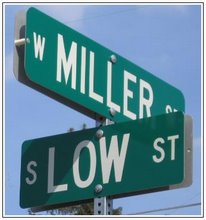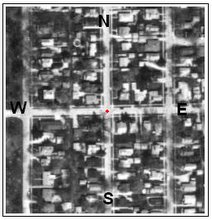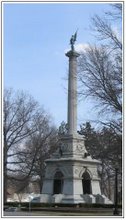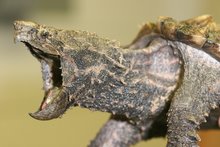
Despite photographic evidence to the contrary, the Miller Park locomotive was never equipped with a wind-up key so children could watch the locomotive wind its way up and down the park's meandering pathways.
A Pantagraph photographer snapped a photo on Oct. 17, 1959, two days after the steam locomotive was moved to Miller Park. Evidently, anonymous pranksters thought the addition of an oversized cardboard "key" was good for a laugh or two.
Practical jokes aside, the sight of this steam-age behemoth ought to lead more curious park visitors to ponder the following questions: Why exactly is there a locomotive in Miller Park? And, perhaps more urgently, how the heck did it get there?
The engine stands at Miller Park to commemorate the days when Bloomington's economic lifeblood was not insurance, but rather the railroad industry. In 1853, the first two railroads to reach Bloomington - the Illinois Central in the spring and what would become the Chicago and Alton in the fall - transformed what was a rather isolated county seat into one of the state's fastest-growing cities. The agricultural riches of the countryside could be shipped out, and finished goods shipped in, at heretofore-unimagined speed and economies of scale.
Other railroads followed, and by the early 1880s, more men worked at the Chicago and Alton shops on Bloomington's west side than anywhere else in the city.
The Miller Park locomotive was an iron and steel workhorse for the Nickel Plate Road, one of the later lines to run through Bloomington. Built in 1923 and designated No. 639, this particular freight engine was no stranger to Bloomington, making regular runs down the line from Frankfort, Ind. to Peoria.
The 2-8-2-wheel design makes it a "Mikado," a curious name dating to the late 1800s when the Japanese government ordered engines of this type from a U.S. locomotive manufacturer.
Eventually, more than 14,000 Mikados were built and operated in the United States, making it the most popular steam locomotive in the nation's history.
In the mid-1950s, Bloomington residents interested in commemorating the city's railroad history lobbied Mayor Bob McGraw to display a retired locomotive at Miller Park.
McGraw thought the idea a grand one, but only if undertaken without public funds. The result was the establishment of the Bloomington Steam Locomotive Commission, a group of rail fans and past and current railroad employees who raised $6,000 to pay for the ambitious project.
Getting the engine to Miller Park was no mean feat. Movers first jacked the engine onto a frame of steel girders. They then slipped under that frame three dollies with a total of 48 rubber wheels.
The 12-block journey from the warehouse district south of downtown to Miller Park was touch-and-go, especially when the heavy truck crane pulling the engine began spinning its wheels on the Center Street incline near Oakland Avenue. Fortunately, two smaller trucks came to the rescue.
On Nov. 1, 1959, Myron B. Phipps, vice president of operations for the Nickel Plate Road, dedicated the locomotive, calling it Bloomington's "First Citizen."
In the summer of 1996, the Central Illinois Railroad Club added a Southern Pacific Railroad caboose to take its place behind the old Nickel Plate engine and tender.
By the mid-1980s, railroads began phasing out cabooses in favor of "end-of-train devices," small metal boxes attached to the rear coupler of the last car that relay information to the engineer, such as brake pressure.
Thus the caboose, much like the steam engine, stands as a relic of a bygone era.
This article came from the PANTAGRAPH.



















































